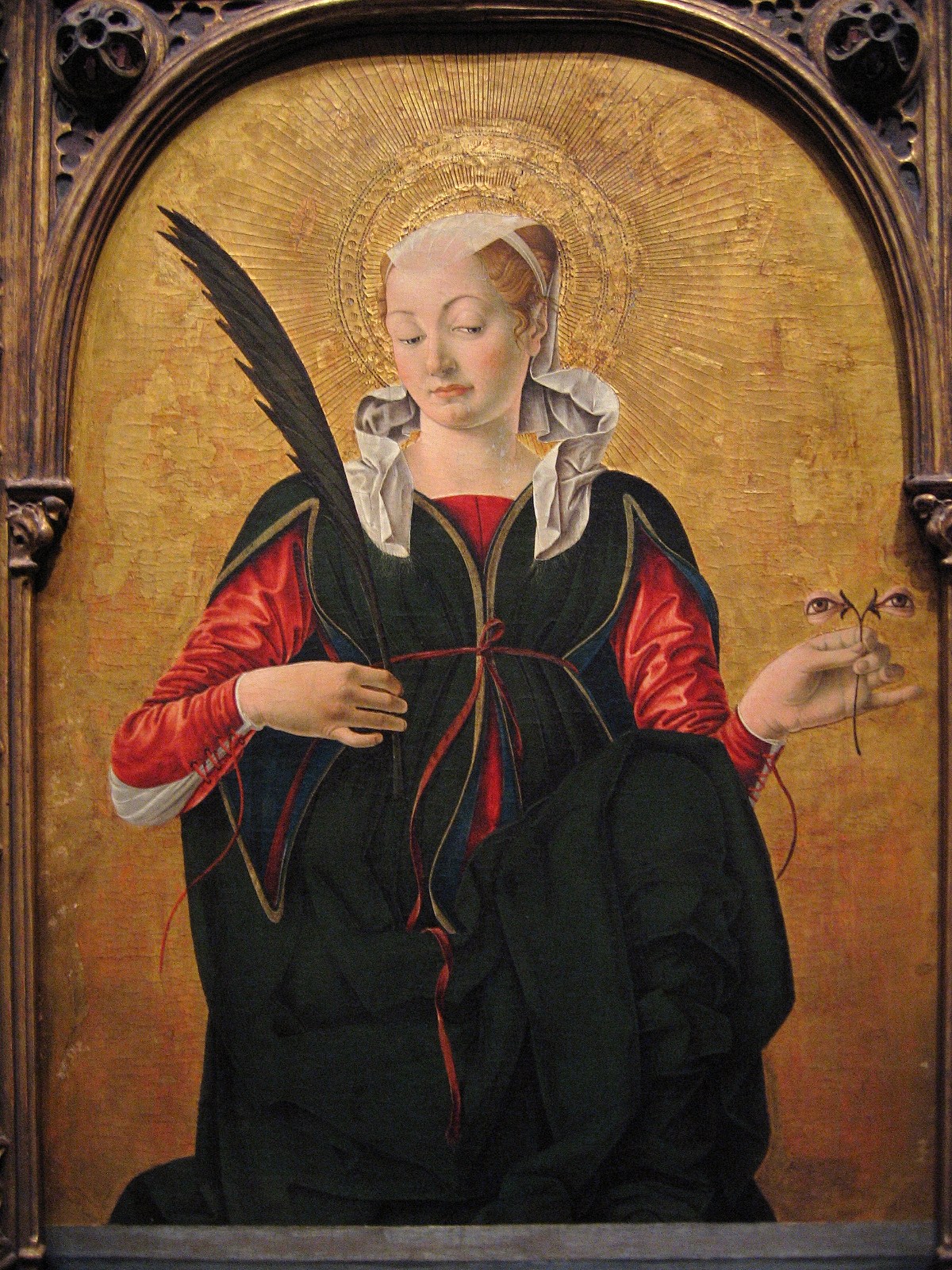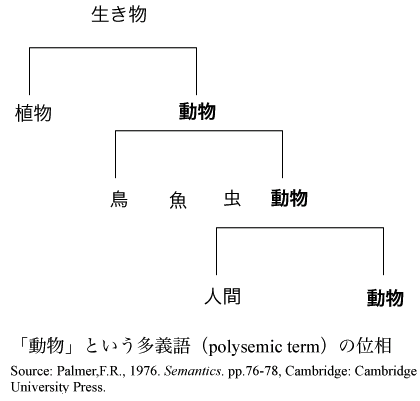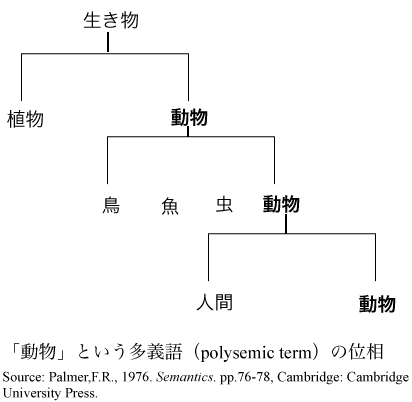
Santa Lucía de Siracusa, pintor Francesco del Cossa (c. 1430 – c.
1477)
ケイパビリティ・アプローチにおける動物の範疇化の失敗について
We
cannot think as thou, the animals,
may think...

Santa Lucía de Siracusa, pintor Francesco del Cossa (c. 1430 – c.
1477)
AIU(キャンベラ)でおこなわれたタン ナー(ターナー)講義の、ヌスバウム、マーサ「「同情と慈愛」を超えて」『正義のフロンティア』神島裕 子訳、 Pp.371-463、法政大学出版局、2012年は、ケイパビリティ・アプローチという観点から、「動物」の尊厳ある命(と生活)を保障すべき、人間側 への提言としては、非常に力強いものである。しかし、彼女が擁護すべき「動物」の範疇とは、ライオン、犬、ヘラジカに加えて、ミミズや蚊などが含まれる。 しかしながら、依然として、そこでケイパビリティに基づく擁護の前提になっているのは、脊椎動物のうちでも主にほ乳類がその「想定される動物」である。も しかりに、あらゆる動物が包摂されるなら、それは種の多様性を前提にする生態環境の擁護概念に結びつくだろうか?もし、そうだとしたら、今度はケイパビリ ティ・アプローチを植物にまで拡張しなければならなくなる。このような混乱が生じるのは、彼女が動物という時に、じつはどのようなものをケイパビリティ・ アプローチで擁護すべきかの前提ないしは「モデル動物」(=私の邪推では、脊椎動物のうちでも主にほ乳類)があり、それに基づいており、そのことを読者に きちんと明示せずに、御自身の議論を展開されているからである。
我々が動物という時には、さまざまな階層 化(下記を参照)がなされており、彼女の議論に我々自身が隔靴掻痒感をもつのはそのことによるものなの だろう。
我々が(人間以外の)動物の思考を、彼らが思うよう(as they may think)には、考えることができない。(→「パース ペクティヴィズム」)
我々の認識の範囲が、我々の思考の範囲で ある。——「私の言語の限界が私の世界の限界を意味する(Die Grenzen meiner Sprache bedeuten die Grenzen meiner Welt)」ウィ トゲンシュタイン『論理哲学論考』5.6
それは可能だというのが:一人称知識の復権(ジョン・サール)である。
◎プロジェクト:「動物学者と動物の科学民族誌」2014年度
〜2016年度挑戦的萌芽研究(研究課題番号: 26560137)

◎ ウィトゲンシュタイン『哲学探究』と動物:http: //www.geocities.jp/mickindex/wittgenstein/witt_pu_jp.html
25. 人はときに、動物が話さないのは、彼らに精神的な能力が欠如しているからだ、と言う。つまり、「動物は考えない。ゆえに話さない」というわけだ。だが、動 物は [考えないから話さないのではなく] まさに話さないのである。より正確には、動物は —— 原初的な言語形態を無視すれば —— 言語を使用しないのである。 —— 命令する、質問する、数える、雑談するなどの言語行為は、行く、食べる、飲む、遊ぶなどの行為と同様に、私たちの自然史に属しているのである。
495. 明らかなことだが、ある人間(または動物)がある記号に対して私が望むように反応し、他の記号に対してはそうしないということを確認できるのは、経験に よってである。例えばある人が「—→」という記号に対しては右に、「←—」という記号に対しては左に進むが、「o—|」という記号に対しては「—→」とい う記号と同じようには反応しない、等々。/そう、私はどんな事例も考え出す必要は無く、ドイツ語だけを学んだ人間は、ドイツ語を使うことでしか操れないと いう現実を考察すれば足りるのである。(なぜならいま私は、ドイツ語の習得者であるということを、ある種の影響に対するメカニズムの調節と見なしているか らである。だから、他の人がドイツ語を学んだのか、あるいは生まれつきドイツ語の文に対して、普通の人間がドイツ語を習得した場合と同じように反応するの かどうかということは、気にしなくてよいからである。)
★ 動物記号学(Zoosemiotics)
| Zoosemiotics
is the semiotic study of the use of signs among animals, more precisely
the study of semiosis among animals, i.e. the study of how something
comes to function as a sign to some animal.[1] It is the study of
animal forms of knowing.[2] Considered part of biosemiotics, zoosemiotics is related to the fields of ethology and animal communication. It was developed by semiotician Thomas Sebeok based on the theories of German-Estonian biologist Jakob von Uexküll.[3][4] The field is defined by having as its subject matter all of those semiotic processes that are shared by both animals and humans.[5] The field also differs from the field of animal communication in that it also interprets signs that are not communicative in the traditional sense, such as camouflage, mimicry, courtship behavior etc. The field also studies cross-species communication, for example between humans and animals.[6] Maran, Timo; Martinelli, Dario; Turovski, Aleksei (eds.), 2011. Readings in Zoosemiotics. (Semiotics, Communication and Cognition 8.). Berlin: De Gruyter Mouton. Kull, Kalevi 2014. Zoosemiotics is the study of animal forms of knowing. Semiotica 198: 47–60.[1] "Zoosemiotics". Thomas A. Sebeok. American Speech , Vol. 43, No. 2 (May, 1968), pp. 142-144 Zoosemiotics: Juncture of Semiotics and the Biological Study of Behavior. Science 29 January 1965: Vol. 147 no. 3657 pp. 492-493 Baer, Eugen. 1987. Thomas A. Sebeok's Doctrine of Signs, in Krampen, et al. (eds.) "Classics of Semiotics" Plenum Press. p. 187 Martinelli, Dario. "Zoosemiotics" in Semiotics Encyclopedia Online. E.J. Pratt Library - Victoria University. https://en.wikipedia.org/wiki/Zoosemiotics |
動物記号論とは、動物における記号の使用に関する記号論的研究であり、
より正確には、動物における記号論の研究である。つまり、動物にとって何かがどのように記号として機能するのかを研究するのである。 生物記号論の一部と考えられている動物記号論は、動物倫理学や動物コミュニケーションの分野と関連している。ドイツ系エストニア人の生物学者ヤコブ・フォ ン・ユクスキュルの理論に基づき、記号学者トーマス・セベオクによって発展させられた。この分野は、動物と人間の双方に共通するすべての記号論的プロセス を主題とすることで定義されている。また、カモフラージュ、擬態、求愛行動など、伝統的な意味でのコミュニケーションではないサインも解釈するという点 で、アニマルコミュニケーションの分野とは異なる。また、この分野では、例えば人間と動物の間のような、種を超えたコミュニケーションも研究している。 |
| Biosemiotics Phytosemiotics |
|
| Biosemiotics
(from the Greek βίος bios, "life" and σημειωτικός sēmeiōtikos,
"observant of signs") is a field of semiotics and biology that studies
the prelinguistic meaning-making, biological interpretation processes,
production of signs and codes and communication processes in the
biological realm.[1] Biosemiotics integrates the findings of biology and semiotics and proposes a paradigmatic shift in the scientific view of life, in which semiosis (sign process, including meaning and interpretation) is one of its immanent and intrinsic features.[2] The term biosemiotic was first used by Friedrich S. Rothschild in 1962,[3] but Thomas Sebeok, Thure von Uexküll, Jesper Hoffmeyer and many others have implemented the term and field.[4] The field is generally divided between theoretical and applied biosemiotics. Insights from biosemiotics have also been adopted in the humanities and social sciences, including human-animal studies, human-plant studies[5][6] and cybersemiotics.[7] |
バイオセミオティコス(ギリシャ語のβίος
bios「生命」とσημειωτικός
sēmeiōtikos「記号の観察者」から)は、記号論と生物学の一分野であり、生物学的領域における前言語的な意味生成、生物学的解釈過程、記号と
コードの生成、コミュニケーション過程を研究する[1]。 生物記号論は、生物学と記号論の知見を統合し、記号論(意味と解釈を含むサインプロセス)がその内在的かつ本質的な特徴のひとつであるという、生命に対す る科学的見解のパラダイムシフトを提唱している。 [2] バイオセミオティックという用語は、1962年にフリードリヒ・S・ロスチャイルドによって初めて使用された[3]が、トーマス・セベオク、トゥーレ・ フォン・ユクスキュル、イェスパー・ホフマイヤー、その他多くの人々がこの用語と分野を実装している[4]。 バイオセミオティックスの見識は、人間-動物学、人間-植物学[5][6]、サイバーセミオティクス[7]など、人文科学や社会科学の分野でも取り入れら れている。 |
| Definition Biosemiotics is the study of meaning making processes in the living realm, or, to elaborate, a study of signification, communication and habit formation of living processes semiosis (creating and changing sign relations) in living nature the biological basis of all signs and sign interpretation interpretative processes, codes and cognition in organisms Main branches According to the basic types of semiosis under study, biosemiotics can be divided into vegetative semiotics (also endosemiotics, or phytosemiotics),[8] the study of semiosis at the cellular and molecular level (including the translation processes related to genome and the organic form or phenotype);[9] vegetative semiosis occurs in all organisms at their cellular and tissue level; vegetative semiotics includes prokaryote semiotics, sign-mediated interactions in bacteria communities such as quorum sensing and quorum quenching. zoosemiotics or animal semiotics,[10] or the study of animal forms of knowing;[11] animal semiosis occurs in the organisms with neuromuscular system, also includes anthroposemiotics, the study of semiotic behavior in humans. According to the dominant aspect of semiosis under study, the following labels have been used: biopragmatics, biosemantics, and biosyntactics. |
定義 生物記号論とは、生きている領域における意味形成過程の研究である。 生きた過程における意味づけ、コミュニケーション、習慣形成 生きている自然におけるセミオシス(記号関係の創造と変化 すべての記号と記号解釈の生物学的基礎 生物における解釈過程、コード、認知 主な分類 研究対象とする記号論の基本的なタイプによって、生物記号論は次のように分けられる。 植生記号論(エンド記号論、または植物記号論でもある)[8]。細胞および分子レベルでの記号論(ゲノムと有機的形態または表現型に関連する翻訳プロセス を含む)の研究[9]。植生記号論は、すべての生物において細胞および組織レベルで発生する。植生記号論には、原核生物の記号論、すなわちクオラムセンシ ングやクオラムクエンチングといった細菌群集における記号を介した相互作用が含まれる。 動物記号論または動物記号論[10]、すなわち動物の「知る」形態の研究[11]。動物記号論は、神経筋系を持つ生物で発生し、人間記号論、すなわち人間 の記号的行動の研究も含まれる。 研究対象のセミオシスの支配的な側面に応じて、以下のラベルが使用されている:バイオ語用論、バイオスマンティクス、バイオシンタクティクス。 |
| History Apart from Charles Sanders Peirce (1839–1914) and Charles W. Morris (1903–1979), early pioneers of biosemiotics were Jakob von Uexküll (1864–1944), Heini Hediger (1908–1992), Giorgio Prodi (1928–1987), Marcel Florkin (1900–1979) and Friedrich S. Rothschild (1899–1995); the founding fathers of the contemporary interdiscipline were Thomas Sebeok (1920–2001) and Thure von Uexküll (1908–2004).[12] In the 1980s a circle of mathematicians active in Theoretical Biology, René Thom (Institut des Hautes Etudes Scientifiques), Yannick Kergosien (Dalhousie University and Institut des Hautes Etudes Scientifiques), and Robert Rosen (Dalhousie University, also a former member of the Buffalo group with Howard H. Pattee), explored the relations between Semiotics and Biology using such headings as "Nature Semiotics",[13][14] "Semiophysics",[15] or "Anticipatory Systems" [16] and taking a modeling approach. The contemporary period (as initiated by Copenhagen-Tartu school)[17] include biologists Jesper Hoffmeyer, Kalevi Kull, Claus Emmeche, Terrence Deacon, semioticians Martin Krampen, Paul Cobley, philosophers Donald Favareau, John Deely, John Collier and complex systems scientists Howard H. Pattee, Michael Conrad, Luis M. Rocha, Cliff Joslyn and León Croizat. In 2001, an annual international conference for biosemiotic research known as the Gatherings in Biosemiotics[18] was inaugurated, and has taken place every year since. In 2004, a group of biosemioticians – Marcello Barbieri, Claus Emmeche, Jesper Hoffmeyer, Kalevi Kull, and Anton Markoš – decided to establish an international journal of biosemiotics. Under their editorship, the Journal of Biosemiotics was launched by Nova Science Publishers in 2005 (two issues published), and with the same five co-editors Biosemiotics was launched by Springer in 2008. The book series Biosemiotics (Springer), edited by Claus Emmeche, Donald Favareau, Kalevi Kull, and Alexei Sharov, began in 2007 and has since published 23 volumes. The International Society for Biosemiotic Studies was established in 2005 by Donald Favareau and the five editors listed above.[19] A collective programmatic paper on the basic theses of biosemiotics appeared in 2009.[20] and in 2010, an 800 page textbook and anthology, Essential Readings in Biosemiotics, was published, with bibliographies and commentary by Donald Favareau.[1] One of roots for biosemiotics has been medical semiotics. In 2016, Springer published Biosemiotic Medicine: Healing in the World of Meaning, edited by Farzad Goli as part of Studies in Neuroscience, Consciousness and Spirituality.[21] In the humanities Since the work of Jakob von Uexküll and Martin Heidegger, several scholars in the humanities have engaged with or appropriated ideas from biosemiotics in their own projects; conversely, biosemioticians have critically engaged with or reformulated humanistic theories using ideas from biosemiotics and complexity theory. For instance, Andreas Weber has reformulated some of Hans Jonas's ideas using concepts from biosemiotics,[22] and biosemiotics have been used to interpret the poetry of John Burnside.[23] Since 2021, the American philosopher Jason Josephson Storm has drawn on biosemiotics and empirical research on animal communication to propose hylosemiotics, a theory of ontology and communication that Storm believes could allow the humanities to move beyond the linguistic turn.[24] John Deely's work also represents an engagement between humanistic and biosemiotic approaches. Deely was trained as a historian and not a biologist but discussed biosemiotics and zoosemiotics extensively in his introductory works on semiotics and clarified terms that are relevant for biosemiotics.[25] Although his idea of physiosemiotics was criticized by practicing biosemioticians, Paul Cobley, Donald Favareau, and Kalevi Kull wrote that "the debates on this conceptual point between Deely and the biosemiotics community were always civil and marked by a mutual admiration for the contributions of the other towards the advancement of our understanding of sign relations."[26] |
歴史 チャールズ・サンダース・パイアース(1839-1914)とチャールズ・W・モリス(1903-1979)を除けば、生物記号論の初期のパイオニアはヤ コブ・フォン・ユクスキュル(1864-1944)、ハイニ・ヘディガー(1908-1992)、ジョルジョ・プロディ(1928-1987)、マルセ ル・フローキン(1900-1979)、フリードリヒ・S・ロスチャイルド(1899-1995)である。ロスチャイルド(1899-1995)であり、 現代の学際領域の創始者はトーマス・セベオク(1920-2001)とテューレ・フォン・ユクスキュル(1908-2004)であった[12]。 1980年代には、理論生物学で活躍する数学者のサークル、ルネ・トム(Institut des Hautes Etudes Scientifiques)、ヤニック・ケルゴシアン(Dalhousie University and Institut des Hautes Etudes Scientifiques)、ロバート・ローゼン(Dalhousie University、Howard H. Patteeと共にバッファローグループの元メンバーでもある)が、理論生物学との関係を探求した。13][14]、「半物理学」[15]、「予期システ ム」[16]などの見出しをつけ、モデリング的なアプローチを用いて、記号論と生物学の関係を探求した。 現代(コペンハーゲン・タルトゥ学派によって始まった)[17]には、生物学者イェスパー・ホフマイヤー、カレヴィ・クル、クラウス・エメッシュ、テレン ス・ディーコン、記号学者マーティン・クランペン、ポール・コブリー、哲学者ドナルド・ファヴァロー、ジョン・ディーリー、ジョン・コリアー、複雑系科学 者ハワード・H・パティ、マイケル・コンラッド、ルイス・M・ロシャ、クリフ・ジョスリン、レオン・クロイザットらがいる。 2001年には、「バイオセミオティクスの集い」[18]として知られるバイオセミオティクス研究のための年次国際会議が発足し、以来毎年開催されてい る。 2004年、マルチェロ・バルビエリ、クラウス・エメッシュ、イェスパー・ホフマイヤー、カレヴィ・クル、アントン・マルコシュというバイオセミオティ シャンのグループが、バイオセミオティクスの国際ジャーナルを創刊することを決定した。彼らの編集の下、Journal of Biosemioticsは2005年にNova Science Publishersから創刊され(2号発行)、2008年には同じ5人の共同編集者によりBiosemioticsがSpringerから創刊された。 クラウス・エメッシュ、ドナルド・ファヴァロー、カレヴィ・クル、アレクセイ・シャロフが編集する書籍シリーズ『Biosemiotics』 (Springer)は2007年に始まり、これまでに23巻が出版されている。 国際バイオセミオティクス学会は、ドナルド・ファヴァローと上記の5人の編集者によって2005年に設立された[19]。2009年には、バイオセミオ ティクスの基本的なテーゼに関する集合的なプログラム論文が発表され[20]、2010年には、800ページの教科書とアンソロジー『Essential Readings in Biosemiotics』が出版され、ドナルド・ファヴァローによる書誌と解説が掲載された[1]。 バイオセミオティックスのルーツのひとつは、医療記号論である。2016年、シュプリンガー社は『Biosemiotic Medicine』を出版した: Studies in Neuroscience, Consciousness and Spiritualityの一部として、ファルザッド・ゴリが編集した『Healing in the World of Meaning』が出版された[21]。 人文科学において ヤーコプ・フォン・ユクスキュルやマルティン・ハイデガーの研究以来、人文科学分野の何人かの学者が、バイオセミオティクスのアイデアを自身のプロジェク トに取り入れたり、流用したりしている。逆に、バイオセミオティシャンは、バイオセミオティクスや複雑性理論のアイデアを用いて、人文科学的理論に批判的 に関与したり、再構築したりしている。例えば、アンドレアス・ウェーバーはハンス・ヨナスの思想の一部をバイオセミオティクスの概念を用いて再定義してお り[22]、ジョン・バーンサイドの詩を解釈するためにバイオセミオティクスが用いられている[23]。 2021年以降、アメリカの哲学者であるジェイソン・ジョセフソン・ストームは、バイオセミオティクスと動物のコミュニケーションに関する実証的な研究を もとに、人文学が言語的転回を超えることができるとストームが考える存在論とコミュニケーションの理論であるハイロセミオティクスを提唱している [24]。 ジョン・ディーリーの仕事もまた、人文学的アプローチと生物記号論的アプローチとの関わりを象徴している。ディーリーは生物学者ではなく歴史学者として訓 練を受けたが、記号論の入門書の中で生物記号論と動物記号論を幅広く論じ、生物記号論に関連する用語を明確にしている。 [25]。彼のフィジオセミオティクスの考えは実践的なバイオセミオティシャンから批判されたが、ポール・コブリー、ドナルド・ファヴァロー、カレヴィ・ クルは「ディーリーとバイオセミオティクスのコミュニティとの間のこの概念的な点に関する議論は常に礼儀正しく、記号関係の理解の進歩に向けた他者の貢献 に対する相互の賞賛によって特徴づけられていた」と書いている[26]。 |
| Animal communication Biocommunication (science) Cognitive biology Ecosemiotics Mimicry Naturalization of intentionality Phytosemiotics Plant communication Zoosemiotics |
アニマルコミュニケーション バイオコミュニケーション(科学) 認知生物学 エコセミオティクス 擬態 意図性の自然化 植物記号論 植物コミュニケーション 動物生態学 |
| https://en.wikipedia.org/wiki/Biosemiotics |
|
| Phytosemiotics
is a branch of biosemiotics that studies the sign processes in plants,
or more broadly, the vegetative semiosis. Vegetative semiosis is a type
of sign processes that occurs at cellular and tissue level, including
cellular recognition, plant perception, plant signal transduction,
intercellular communication, immunological processes, etc. The term 'phytosemiotics' was introduced by Martin Krampen in 1981. Affifi, Ramsey 2013. Learning plants: Semiotics between the parts and the whole. Biosemiotics 6: 547–559. Deely, John 1982. On the notion of phytosemiotics. In: Deely, J. and Evans, J. (eds.), Semiotics 1982. Lanham: University Press of America, 541–554. Faucher, Kane 2014. Phytosemiotics revisited: Botanical behavior and sign transduction. Semiotica 202: 673–688. Krampen, Martin 1981. Phytosemiotics. Semiotica 36(3/4): 187–209. Krampen, Martin 1992. Phytosemiotics revisited. In: Sebeok, Thomas A.; Umiker-Sebeok, Jean (eds.), Biosemiotics: The Semiotic Web 1991. Berlin: Mouton de Gruyter, 213–219. Kull, Kalevi 2000. An introduction to phytosemiotics: Semiotic botany and vegetative sign systems. Sign Systems Studies 28: 326–350. Kull, Kalevi 2009. Vegetative, animal, and cultural semiosis: The semiotic threshold zones. Cognitive Semiotics 4: 8–27. Kull, Kalevi 2023. Necessary conditions for semiosis: A study of vegetative subjectivity, or phytosemiotics. In: Coca, Juan R.; Rodríguez, Claudio J. (eds.), Approaches to Biosemiotics. Valladolid: Ediciones Universidad Valladolid, 59–74. Witzany, Günther 2006. Plant communication from biosemiotic perspective. Plant Signaling & Behavior 1(4): 169–178. https://en.wikipedia.org/wiki/Phytosemiotics |
植物記号論は生物記号論の一分野であり、植物における記号過程、より広
義には植生記号論を研究している。植生的セミオシスは、細胞認識、植物知覚、植物シグナル伝達、細胞間コミュニケーション、免疫学的プロセスなどを含む、
細胞および組織レベルで起こるサインプロセスの一種である。 植物記号論」という言葉は、1981年にマーティン・クランペンによって紹介された。 |
| Plant perception (physiology) Plant communication Hormonal sentience Zoosemiotics International Society for Biosemiotic Studies |
植物の知覚(生理学) 植物コミュニケーション ホルモン感覚 動物生態学 国際バイオセミオティクス学会 |
★
リンク

参 考文献
その他の情報

Copyleft, CC, Mitzub'ixi Quq Chi'j, 1996-2099
++
Copyleft,
CC, Mitzub'ixi Quq Chi'j, 1996-2099